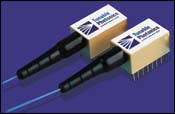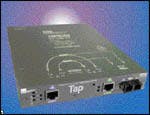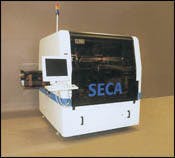Premier Products
Semiconductor optical amplifier
Semiconductor optical amplifiers (SOAs) are available in a polarization-independent (CQF872) and polarization-maintaining (CQF871) module. The gain is 20 dB and 16 dB, respectively (typical), with typical saturation output power for both modules at 20 dBm.
The polarization-dependent gain is 1 dB (typical) for the CQF872. The CQF871 also includes two optical isolators integrated within the package. Both modules are available now, with a sampling lead time of one to two weeks after receipt of order and a lead time of six to eight weeks for larger quantities. The two modules are targeted at the metro market and carry a price of less than $2,000 each in volume.
JDS Uniphase Corp., San Jose, CA
Wavelength locker
The TrueLock wavelength locker is a low-cost, small-package device for setting and stabilizing transmitted wavelengths emitted by tunable and fixed lasers. The locker is available in a hermetically sealed external package and as an internal subassembly for integration into laser transmitter modules. The locker provides accuracy to ±1 GHz and is available for 100-, 50-, and 25-GHz spacings. The internal version requires no active mechanical tilt alignment during the manufacturing process, which reduces cost and improves yield. The device is based on a proprietary temperature-controlled etalon approach. The locker is available in evaluation unit samples, with general availability of Telcordia-qualified units in the first quarter of 2002.
Tunable Photonics Corp., Pasadena, CA
ASE noise blocker
The WSF-32002 two-port reconfigurable ASE noise blocker allows reconfigurable filtering of ASE from an erbium-doped fiber amplifier. The device comprises 32 Bragg gratings that can be switched individually into either blocking or pass-through mode, depending on whether a channel is being added or has been passed. It operates over the C-band and provides insertion-loss uniformity of 0.5 dB over 32 channels at 100-GHz spacing. In-to-out insertion loss, including PDL and ripple, is 3 dB worst case over the 32 channels.
Polatis, Cambridge, UK
Lightwave polarization controllers
The PC4000 series Lightwave polarization controllers adjust polarization states in multiple channels and provide a "save and recall" function and auto-scan modes at several scanning speeds. The systems provide low insertion loss and a high polarization extinction ratio. Polarization states can be manipulated manually or via remote control. The systems have an all-fiber configuration and feature low backreflection, automatic full-range scanning via two- or four-quarter waveplates, and compact size. They can be applied to multichannel polarization controlling, PMD emulation, and multichannel measurements of such factors as PDL. The PC4002-(1) is a two-channel device and the PC4004-(1) is a four-channel system.
Fiberpro, Taejon, South Korea
Copper-to-fiber tap
The GigaBit TX to SX tap enables two devices communicating via GigaBit TX copper cables to be monitored by a fiber SX analyzer. Installing the tap enables migration to copper gigabit Ethernet while retaining compatibility with the monitoring and intrusion detection technologies available for fiber networks. The tap features CDR, ensuring that the overall jitter budget is not exceeded when the tap is deployed. The tap also incorporates echo-cancellation circuitry for reduced "near-end crosstalk" and "far-end crosstalk" interference. Additional features include half- or full-duplex transmission support at 1 Gbit/sec for up to 220 m of transmission distance and two load-sharing power supplies.
Net Optics Inc., Sunnyvale, CA
Lightwave probe
The lightwave probe is part of a photonic-device characterization solution for on-wafer and in-module devices. Its vertical orientation is ideal for PIN, APD, and VCSEL characterization. Coupled with the manufacturer's RF/microwave probes and WinCal calibration software, the probe provides at-frequency testing for 40-Gbit/sec devices and beyond. The lightwave probe makes use of a variety of user-interchangeable optical fibers, including lensed tips, to meet diverse testing needs. The probe's patented contact protection feature prevents device damage due to accidental contact.
Cascade Microtech Inc., Beaverton, OR
MEMS wafer/die test system
The DynamiX optical MEMS wafer/die test systems provide semiautomated testing of MEMS and MOEMS, offering an integrated solution optimized for medium-volume and pilot production of MOEMS devices. Users can test and characterize a wide range of MOEMS devices, including VOAs, optical switches, OXCs, and 2-D and 3-D micro-mirror arrays. The system provides optical, electrical, and mechanical testing in an integrated system. Typical measurements include characterization of the displacement of the MEMS element as a function of applied stimulus (voltage/current), in-plane and out-of-plane displacement measurements in 6 degrees-of-freedom with nanometer resolution, response time, resonance, and surface characterization measurements such as profilometry. DynamiX incorporates a semiautomated analytical wafer prober, an optical head assembly, and a precision electrical stimulus/measurement package.
Etec Inc., Peabody, MA
Automated fiber splicer
This automated fusion splicer is a modular system capable of performing a variety of tasks centered on the alignment and splicing of fiber in manufacturing applications. The system performs stripping, sonic cleaning, cleaving, splicing, recoating, and testing. The modular design enables customization for differing applications, ease of maintenance, and quick reconfigurability. Initial systems have already been delivered for erbium-doped fiber-amplifier applications.
SECA Photonics AB, Kista, Sweden




